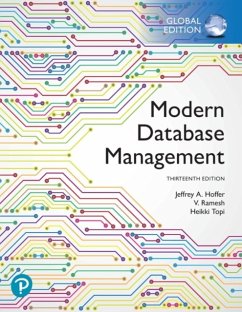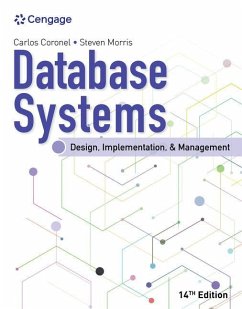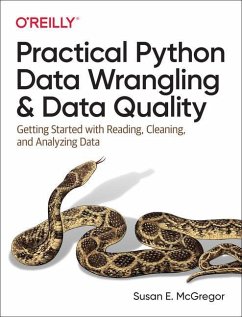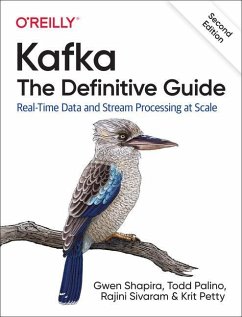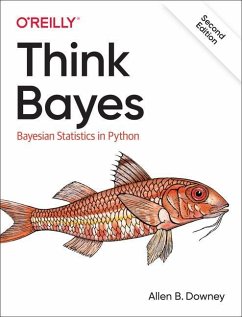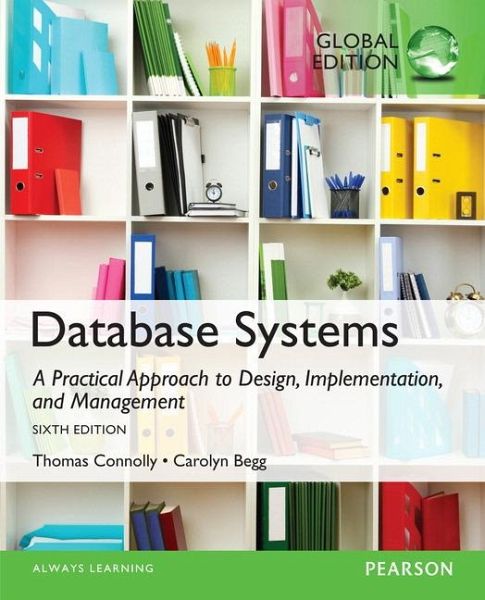
Database Systems: A Practical Approach to Design, Implementation, and Management, Global Edition

PAYBACK Punkte
31 °P sammeln!
This book is ideal for a one- or two-term course in database management or database design in an undergraduate or graduate level course. With its comprehensive coverage, this book can also be used as a reference for IT professionals.
This best-selling text introduces the theory behind databases in a concise yet comprehensive manner, providing database design methodology that can be used by both technical and non-technical readers. The methodology for relational Database Management Systems is presented in simple, step-by-step instructions in conjunction with a realistic worked example using three explicit phases—conceptual, logical, and physical database design.
Teaching and Learning Experience
This program presents a better teaching and learning experience–for you and your students. It provides:
Database Design Methodology that can be Used by Both Technical and Non-technical Readers
A Comprehensive Introduction to the Theory behind Databases
A Clear Presentation that Supports Learning
Features + Benefits
Database Design Methodology that can be Used by Both Technical and Non-technical Readers
Database design methodologyis explicitly divided into three phases based on the widely accepted Entity—Relationship model: conceptual, logical, and physical. Each phase is described in a separate chapter with an integrated case study of the methodology working in practice.
To help the reader use the methodology and understand the important issues, the methodology has been described using a realistic worked example, based on an integrated case study, DreamHome.
Three additional case studies are provided in Appendix B to allow readers to try out the methodology for themselves.
The methodology in each phase is presented as a series of steps. For the inexperienced designer, it is expected that the steps will be followed in the order described, and guidelines are provided throughout to help with this process. For the experienced designer, the methodology can be less prescriptive, acting more as a framework or checklist.
An easy-to-use, step-by-step methodology for physical database design, covers the mapping of the logical design to a physical implementation, the selection of file organizations and indexes appropriate for the applications, and when to introduce controlled redundancy. The integrated case study shows how to use the methodology.
Separate chapters show how database design fits into the overall database systems development lifecycle, how fact-finding techniques can be used to identify the system requirements, and how UML fits into the methodology.
A Clear Presentation that Supports Learning
A clear and easy-to-understand presentationsupports student learning and retention: definitions are highlighted clearly, chapter objectives are stated succinctly, and chapters are summarized completely.
Numerous examples and diagramsthroughout each chapter illustrate the main concepts.
A very practical orientation: each chapter contains many worked examples to illustrate the concepts covered.
UPDATED! New review questions and exercises at the end of chapters can be used by teachers or by individuals to demonstrate and test the individual’s understanding of the chapter.
Instructor Resources, available on the Pearson Instructor Resource Center, include:
Lecture slides in PowerPoint® format
Instructor’s Solutions Manual, including sample solutions to all review questions and exercises
A companion website with additional resources, located at: http://www.aw.com/connollybegg
A Comprehensive Introduction to the Theory behind Databases
UPDATED! Extended chapter on database architectures and the Web, covering cloud computing
NEW! New Section on Data Warehousing and Temporal Databases
Updated treatment to cover the latest version of the SQL standard, which was released late 2011 (SQL:2011)
UPDATED! Extended chapter on replication and mobile databases
UPDATED! Updated chapters on Web-DBMS integration and XML
UPDATED! Extended treatment of XML, SPARQL, XQuery 1.0 and XPath 2.0 (including the new XQuery Update facility), and the new SQL:2011 SQL/XML standard
NEW! Coverage updated to Oracle 11g
Extensive treatment of the latest formal and de facto standards: Structured Query Language (SQL), Query-By-Example (QBE), and the Object Data Management Group (ODMG) standard for object-oriented databases.
Extensive treatment of SQLin three tutorial style chapters, covering both interactive and embedded SQL.
A chapter on legal, professional and ethical issues related to IT and databases.
Comprehensive coverage of the concepts and issues relating to distributed DBMSs and replication servers.
Comprehensive introduction to the concepts and issues relating to object-based DBMSs including a review of the ODMG standard and a tutorial on the object management facilities within the latest release of the SQL standard, SQL:2011.
Extensive treatment of the Web as a platform for database applications with many code samples of accessing databases on the Web. In particular, we cover persistence through Container-Managed Persistence (CMP), Java Data Objects (JDO), Java Persistence API ( JPA), JDBC, SQLJ, ActiveX Data Objects (ADO), ADO.NET, and Oracle PL/SQL Pages (PSP).
An introduction to semistructured data and its relationship to XML and extensive coverage of XML and its related technologies. In particular, we cover XML Schema, XQuery, and the XQuery Data Model and Formal Semantics. We also cover the integration of XML into databases and examine the extensions added to SQL:2003, SQL:2008, and SQL:2011 to enable the publication of XML.
Comprehensive introduction to data warehousing, Online Analytical Processing (OLAP), and data mining.
Comprehensive introduction to dimensionality modeling for designing a data warehouse database. An integrated case study is used to demonstrate a methodology for data warehouse database design.
Coverage of DBMS system implementation concepts, including concurrency and recovery control, security, and query processing and query optimization.
This best-selling text introduces the theory behind databases in a concise yet comprehensive manner, providing database design methodology that can be used by both technical and non-technical readers. The methodology for relational Database Management Systems is presented in simple, step-by-step instructions in conjunction with a realistic worked example using three explicit phases—conceptual, logical, and physical database design.
Teaching and Learning Experience
This program presents a better teaching and learning experience–for you and your students. It provides:
Database Design Methodology that can be Used by Both Technical and Non-technical Readers
A Comprehensive Introduction to the Theory behind Databases
A Clear Presentation that Supports Learning
Features + Benefits
Database Design Methodology that can be Used by Both Technical and Non-technical Readers
Database design methodologyis explicitly divided into three phases based on the widely accepted Entity—Relationship model: conceptual, logical, and physical. Each phase is described in a separate chapter with an integrated case study of the methodology working in practice.
To help the reader use the methodology and understand the important issues, the methodology has been described using a realistic worked example, based on an integrated case study, DreamHome.
Three additional case studies are provided in Appendix B to allow readers to try out the methodology for themselves.
The methodology in each phase is presented as a series of steps. For the inexperienced designer, it is expected that the steps will be followed in the order described, and guidelines are provided throughout to help with this process. For the experienced designer, the methodology can be less prescriptive, acting more as a framework or checklist.
An easy-to-use, step-by-step methodology for physical database design, covers the mapping of the logical design to a physical implementation, the selection of file organizations and indexes appropriate for the applications, and when to introduce controlled redundancy. The integrated case study shows how to use the methodology.
Separate chapters show how database design fits into the overall database systems development lifecycle, how fact-finding techniques can be used to identify the system requirements, and how UML fits into the methodology.
A Clear Presentation that Supports Learning
A clear and easy-to-understand presentationsupports student learning and retention: definitions are highlighted clearly, chapter objectives are stated succinctly, and chapters are summarized completely.
Numerous examples and diagramsthroughout each chapter illustrate the main concepts.
A very practical orientation: each chapter contains many worked examples to illustrate the concepts covered.
UPDATED! New review questions and exercises at the end of chapters can be used by teachers or by individuals to demonstrate and test the individual’s understanding of the chapter.
Instructor Resources, available on the Pearson Instructor Resource Center, include:
Lecture slides in PowerPoint® format
Instructor’s Solutions Manual, including sample solutions to all review questions and exercises
A companion website with additional resources, located at: http://www.aw.com/connollybegg
A Comprehensive Introduction to the Theory behind Databases
UPDATED! Extended chapter on database architectures and the Web, covering cloud computing
NEW! New Section on Data Warehousing and Temporal Databases
Updated treatment to cover the latest version of the SQL standard, which was released late 2011 (SQL:2011)
UPDATED! Extended chapter on replication and mobile databases
UPDATED! Updated chapters on Web-DBMS integration and XML
UPDATED! Extended treatment of XML, SPARQL, XQuery 1.0 and XPath 2.0 (including the new XQuery Update facility), and the new SQL:2011 SQL/XML standard
NEW! Coverage updated to Oracle 11g
Extensive treatment of the latest formal and de facto standards: Structured Query Language (SQL), Query-By-Example (QBE), and the Object Data Management Group (ODMG) standard for object-oriented databases.
Extensive treatment of SQLin three tutorial style chapters, covering both interactive and embedded SQL.
A chapter on legal, professional and ethical issues related to IT and databases.
Comprehensive coverage of the concepts and issues relating to distributed DBMSs and replication servers.
Comprehensive introduction to the concepts and issues relating to object-based DBMSs including a review of the ODMG standard and a tutorial on the object management facilities within the latest release of the SQL standard, SQL:2011.
Extensive treatment of the Web as a platform for database applications with many code samples of accessing databases on the Web. In particular, we cover persistence through Container-Managed Persistence (CMP), Java Data Objects (JDO), Java Persistence API ( JPA), JDBC, SQLJ, ActiveX Data Objects (ADO), ADO.NET, and Oracle PL/SQL Pages (PSP).
An introduction to semistructured data and its relationship to XML and extensive coverage of XML and its related technologies. In particular, we cover XML Schema, XQuery, and the XQuery Data Model and Formal Semantics. We also cover the integration of XML into databases and examine the extensions added to SQL:2003, SQL:2008, and SQL:2011 to enable the publication of XML.
Comprehensive introduction to data warehousing, Online Analytical Processing (OLAP), and data mining.
Comprehensive introduction to dimensionality modeling for designing a data warehouse database. An integrated case study is used to demonstrate a methodology for data warehouse database design.
Coverage of DBMS system implementation concepts, including concurrency and recovery control, security, and query processing and query optimization.
Teach database theory with the bestselling text on the subject Database Systems: A Practical Approach to Design, Implementation, and Management introduces the theory behind databases in a concise yet comprehensive manner. Designed for undergraduate courses, the text is accessible for non-technical readers. This title comes with a Companion Website.






